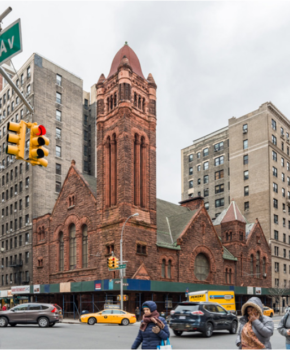Met with both strong support and staunch opposition, a Manhattan church’s hardship application would allow the landmarked building to be demolished. On June 14, 2022, the Landmark Preservation Commission held a public hearing to discuss the future of Individual Landmark West Park Presbyterian Church, located on 165 86th Street in the Upper West Side of Manhattan. The West Park Administrative Commission has applied for a Certificate of Appropriateness to demolish the church building on … <Read More>
West Park Presbyterian Church
West Park church designated
Opponents argued designation would prevent congregation from restoring the deteriorating building. On May 12, 2010, the City Council approved Landmarks’ designation of the West Park Presbyterian Church at 165 West 86th Street in Manhattan. The red sandstone-clad building is considered one of the City’s best examples of Romanesque Revival-style religious structures. Landmarks unanimously designated the building in January 2010 despite opposition from West Park leaders and its congregation, who claimed that designation would prevent the … <Read More>
West Park Presbyterian Church landmarked
Church officials and congregation opposed designation. On January 12, 2010, Landmarks designated West Park Presbyterian Church at 165 West 86th Street in Manhattan’s Upper West Side. The Romanesque Revival building’s development occurred in two phases. Leopold Eidlitz designed a small chapel completed in 1883. When the church outgrew the building in 1889, it commissioned Henry Kilburn to build a new sanctuary and redesign the small chapel’s facade. Kilburn’s design features distinctive red sandstone cladding, round … <Read More>
Church opposes designation
West Side church claims designation will hinder its ability to restore and remain in Romanesque Revival structure. On July 14, 2009, Landmarks heard extensive testimony on the potential designation of West Park Presbyterian Church, at 165 West 86th Street in Manhattan. The red, sandstone- clad Romanesque Revival building was built in two phases. In 1883, the church commissioned Leopold Eidlitz, who also worked on the Tweed Courthouse … <Read More>




